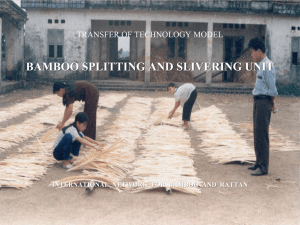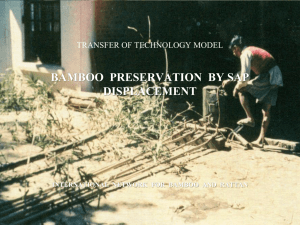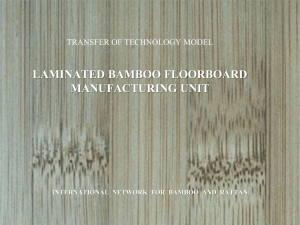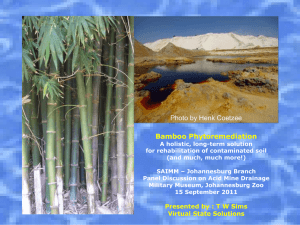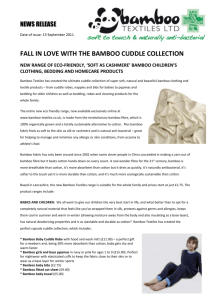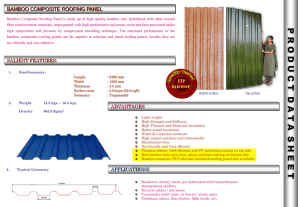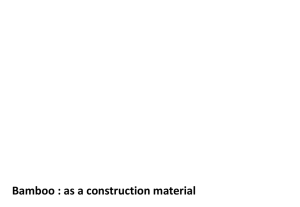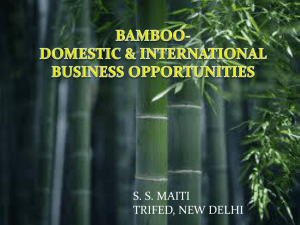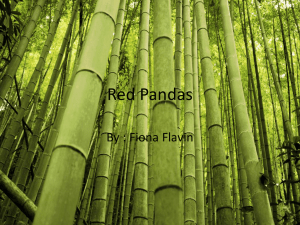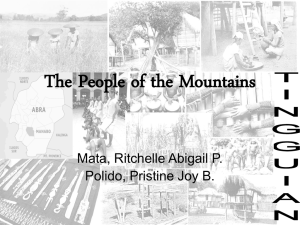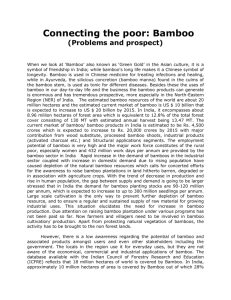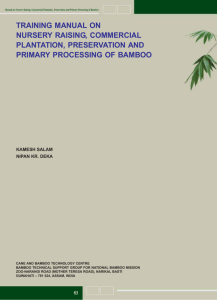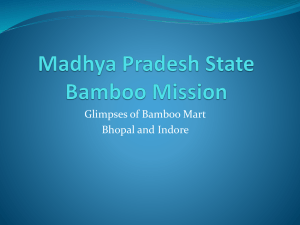What is a medium or large scale bamboo plantation?
advertisement
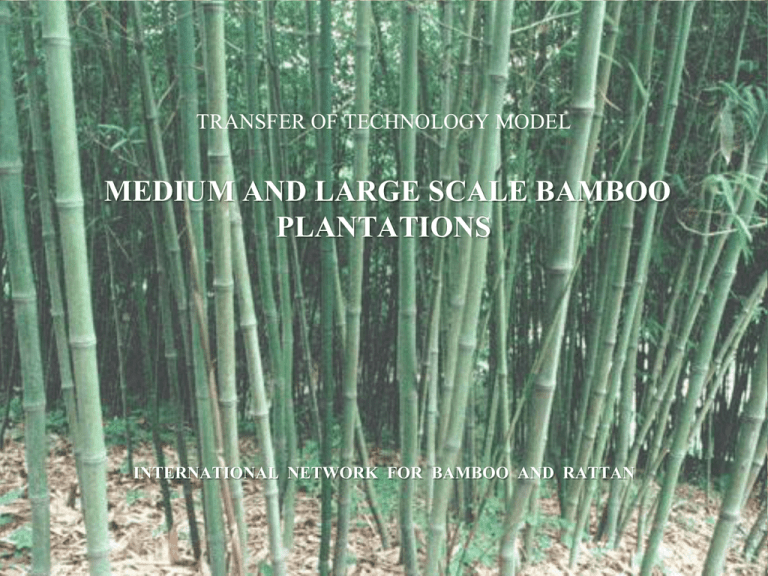
TRANSFER OF TECHNOLOGY MODEL MEDIUM AND LARGE SCALE BAMBOO PLANTATIONS INTERNATIONAL NETWORK FOR BAMBOO AND RATTAN Why bamboo? • Bamboos grow more rapidly than trees and start to yield within three or four years of planting. • Plantation establishment requires minimal capital investment and builds upon the inherent plant-cultivation skills of local farmers and foresters. • Bamboos can be harvested annually and non-destructively. • Bamboos are excellent for rejuvenating degraded lands and protecting against soil erosion. • Bamboos may easily be intercropped with shallow-rooted crops. • As well as the culms, all other parts of the bamboo plant can be used in rural livelihoods - shoots for food, leaves for fodder, and branches for items such as brooms and for firewood. What is a medium or large scale bamboo plantation? • A medium or large scale bamboo plantation is too large for an individual family to manage on its own, and may be from approximately one hectare to many square kilometres in size. • The plantation may be managed for culm production, shoot production or a combination of both, and specific cultivation and harvesting techniques are used, depending on the management strategy adopted. • Most of the commercially productive bamboo plantations in the world are medium or large scale, and they benefit from the economies of their size. How do I establish a medium of large scale bamboo plantation? 1. Select a site: A gently sloping site is ideal, with friable, slightly acidic soil. 2. Select the species: Select species according to their cultivation requirements and the management system used. 3. Prepare the site: Plough the site and incorporate organic matter. 4. Plant the bamboos: One-year-old plantlets are the best planting material. 5. Form support groups: Including groups covering marketing, materials and plantation management. 6. Monitor progress: And take action to continually improve. Main development attributes of a medium or large scale bamboo plantation • Reduces dependence on timber resources and thereby increases environmental protection and conservation. • Permits rehabilitation of degraded lands through increased areas of bamboo plantations and increases land productivity. • Creates employment opportunities because it is labour intensive with very low levels of mechanisation. • Builds on the inherent plant cultivation skills of local farmers and foresters and hence is easily adopted. • Requires organic inputs such as fertiliser for optimum plant growth. Some salient facts The bamboo plantation should be market oriented, otherwise success will be unlikely. The enterprise requires suitable support services and infrastructure to be in place in order to operate properly. Choice of species is important. Bamboos with large culms often have a wider range of uses than those with small culms and certain species are suitable for particular uses. Given the large size of the plantation it may be preferable to establish it as part of a coordinated local or regional bamboo development venture including processing units that the plantation could supply. Photo: Bambusa chungii Requirements for success • Land available for bamboo cultivation • Interest in local communities in planting bamboo. • Start up capital for the purchase of seedlings, fertilisers, tools and labour costs. • Access to expert advice and assistance in the early stages. • Institutional support and infrastructure. • Proper market linkages to the purchasers of the bamboo culms/shoots. Financial aspects of a large scale bamboo plantation* (based on an example from South China) INFRASTRUCTURE COSTS Buildings and roads Equipment TOTAL (US$) $60, 000 $25, 000 $85, 000 WORKING CAPITAL Fertiliser (annually) Transport (annually) Land (annually) Plantlets (1st year only) Salaries (1st year) Salaries (2nd year) Salaries (annually, years 3 - 15) Management(annually) Miscellaneous (annually) $22, 000 $6, 000 $91, 000 $145, 000 $485, 000 $235, 000 $130, 000 $48, 000 $6, 000 TOTAL ANNUAL (YRS 3 - 15) $303, 000 ANNUAL OUTPUTS (US$) YEARS 1 - 3 Zero YEAR 4 $1.1 mil. YEAR 5 $1.2 mil. YEARS 6 - 15 (each) $1.6 mil. Note: Two thirds of outputs come from the sale of shoots, one third from the sale of culms. * All figures are for a 1,000 hectare plantation based on a re-afforestation cycle of 15 years For further information See TOTEMs Community bamboo nursery TOTEM Bamboo shoot plantation TOTEM. Homestead bamboo plantations TOTEM. Smallholder bamboo plantations TOTEM. Community rattan nursery TOTEM. Contact • INBAR, Beijing 100101-80, China • Bamboo Research Division, Research Institute of Subtropical Forestry (RISF), Chinese Academy of Forestry, 73 Daqiao Road, Fuyang, Zhejiang, China. Websites INBAR: www.inbar.int RISF: www.caf.ac.cn/newcaf/english/yls/yls.htm China National Bamboo Research Centre (CNBRC): www.caf.ac.cn/newcaf/english/zzzx/bamboo.htm




